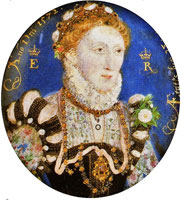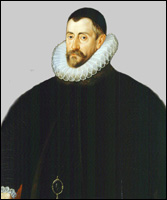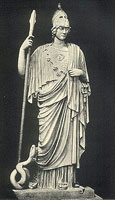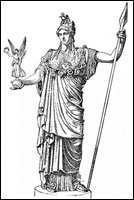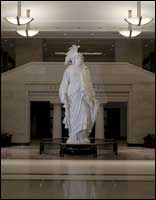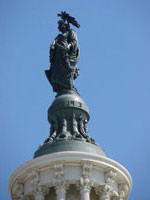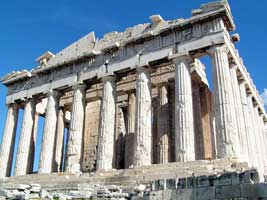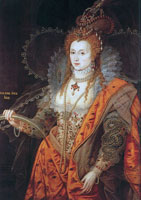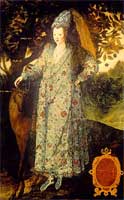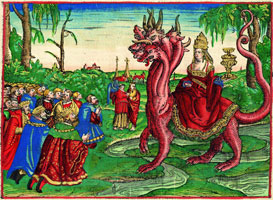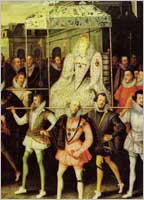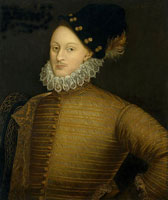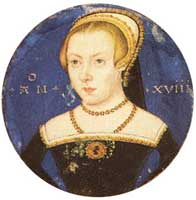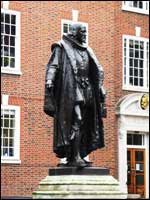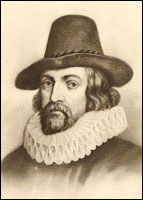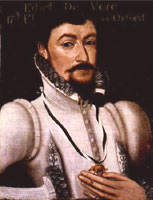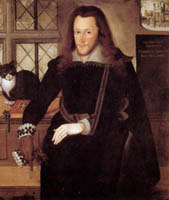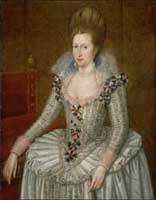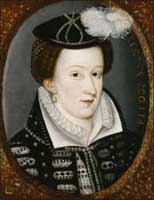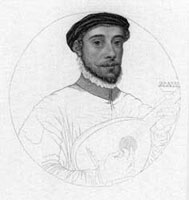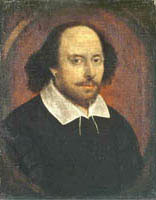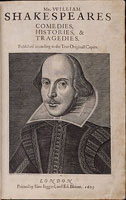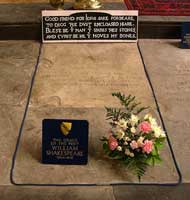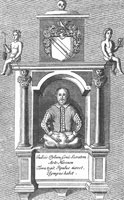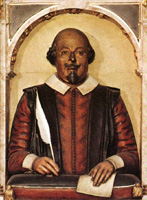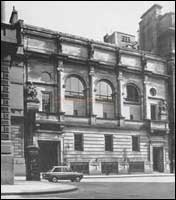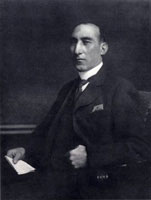THE ELIZABETH DOUBLE WAS THE DAUGHTER OF KING HENRY VIII AND HIS FAVORITE MISTRESS BESSIE BLOUNT! SHE HAD 3 OTHER SISTERS AND ANY OF THEM COULD HAVE PLAYED THE ROLE OF THE LIONESS!! |
THE QUEEN ELIZABETH DOUBLE WAS SHAKE-SPEARE!!
Every year, millions of tourists visited Stratford-on-Avon, the so-called birth and burying place of William "Shakespeare." Little do they realize that the name Shake-speare was a pseudonym for the Queen Elizabeth I double. The real Shake-speare was born in London and is buried in Westminster Abbey.
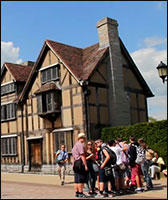 Stratford-on-Avon, the birthplace of William "Shakespeare." |
|
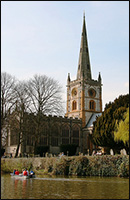 Trinity Church, the burial place of William "Shakespeare". |
Whatever the real name of the Stratford "Shakespeare" actor, he would have been vehemently opposed to cremation. Here is the only poetry he ever wrote!
Good friend for Jesus sake forbear
To dig the dust enclosed here!
Blest be the man that spares these stones,
And curst be he that moves my bones.
Here is what the Stratford "Shakespeare" would write if he was alive today:
Good friend for Jesus sake forbear
To dig the dust enclosed here!
Blest be the man that spares these stones,
And curst be he that burns my bones!
That actor was referring to the burning of the bones of Saint John Wycliffe in 1428....Thankfully for people who lived back then, pagan cremation was not the burning issue that it is today!
Robert Dudley was married to the Shake-speare double!!
Robert Dudley—1st Earl of Leicester—was the husband of the Queen Elizabeth I double. When Saint Martin Luther abolished marriage as a sacrament, the Reformation Parliament in England made marriage by a Roman priest unlawful. From that time onward, marriages could only be performed by a Church of England minister.
Those who shall attempt to contract marriage otherwise than in the presence of the parish priest, or of some other priest by permission of the said parish priest, or of the Ordinary, and in the presence of two or three witnesses; the holy Synod renders such wholly incapable of thus contracting and declares such contracts invalid and null, as by the present decree. It invalidates and annuls them. (Council of Trent, Twenty-fourth Session, Chapter I).
Unfortunately, England still had a sizable portion of the population still adhering to the Papacy and they were also secretly married by priests. The Latin hierarchy looked upon people married by the Church of England as "living in sin," and their children illegitimate!
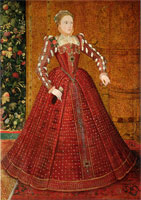 The Queen Elizabeth double. (1540–1603). |
|
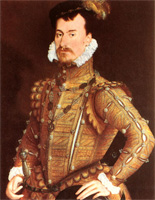 Robert Dudley (1532–1588). |
With the 2 competing legal systems in existence, Elizabeth could claim to be both married and unmarried at the same time. A married with children "Virgin Queen."
By English law their children were ineligible to inherit the throne . . . but the Papacy recognized them as legitimate heirs.
This secret marriage by Elizabeth Tudor and Robert Dudley set a precedent for 2 more top secret marriages: the Prince of Wales in 1785, and Queen Victoria in 1866.
The 2 most momentous events that happened during the life of the Stratford Shakespeare (1564–1616) were the infamous St. Bartholomew's Day Massacre and the defeat of the "Invincible" Spanish Armada. Neither events merited a play . . . or even a poem. In 1592, the playwright Christopher Marlowe (1564–1593) wrote a play entitled The Massacre at Paris but he was murdered folio.
|
When the Elizabeth double heard the news she put on a show of mourning:
By 22 August, the Queen had arrived at Kenilworth to be entertained by Leicester, who had arranged all kinds of 'princely sports.' But on 3 September, while she was out hunting one day, a messenger arrived with a dispatch from Walsingham in Paris that caused her to burst into tears, cancel all further entertainments and send de la Mole back to France. A Spanish agent in London informed Alva that she had 'sent all her musicians and minstrels home, and there are no more of the dances, farces and entertainments with which they have been amusing themselves lately, as they have some less agreeable things to think about.' (Weir, The Life of Queen Elizabeth I, p. 287).
Mary Queen of Scots stayed up all night celebrating, while Pope Gregory XIII was beside himself with joy!
Greek goddess Pallas Athena was Shake Spear!!
The Greek Empire of Alexander the Great was the third universal empire in the Boo k of Daniel. That empire was symbolized as a leopard with wings because of the rapidity of his conquests.
|
In Washington City–the capital of the New Jerusalem–a statue of the Spear-shaker dominates the Capitol.
|
Pallas Athena was also known as the VIRGIN (Greek: Παρθενών), English: Parthenon. Greek gods and goddess were infamous for rape, murder, incest, human sacrifice, etc.etc.
|
Even though she dressed as a warrior, nobody in history has ever claimed that Spear-shaker
The plays were the combined effort of Shake-speare's children!!
There was a plethora of literary talent at the court of the double. Even Bessie Blount wrote poetry, and her 4 daughters inherited her literary talent. Additionally, there were the numerous children of the double.
|
The eyes and ears symbolize spymaster, Sir Francis Walsingham, who knew everything that was happening in her kingdom, and throughout Europe.
Both portraits were painted about 1600. The Persian Portrait is the work of Marcus Gheeraearts the Younger. The paintings are of the queen in her thirties, and are filled with symbols from ancient Greek paganism. The person who commissioned the Persian Portrait wanted to leave a "true portrait" of the "Virgin Queen" for posterity:
When an elderly guard was asked who the subject of the portrait was, he replied that before World War II, the painting was labeled as "Elizabeth," but after the war, it was changed to "anonymous." The reason for such a change is self-evident when one looks at the painting for even a minute. The subject of the painting is pregnant. (Streitz, Oxford: Son of Queen Elizabeth, p. 262).
This is exactly what Saint Paul warned the Christians about...Satan always tries desperately to reverse the natural order or turn the world upside down:
But I fear, lest by any means, as the serpent deceived Eve through his cunning, so your minds should be corrupted from your sincere and pure devotion to Christ (II Corinthians 11:3).
The symbolism of a woman riding or dominating the beastly political is an end-of-the-world scenario:
So he carried me away in the spirit into the wilderness: and I saw a woman sit upon a scarlet coloured beast, full of names of blasphemy, having seven heads and ten horns. And the woman was arrayed in purple and scarlet colour, and decked with gold and precious stones and pearls, having a golden cup in her hand full of abominations and filthiness of her fornication: And upon her forehead was a name written, MYSTERY, BABYLON THE GREAT, THE MOTHER OF HARLOTS AND ABOMINATIONS OF THE EARTH (Apocalypse 17: 3-5).
To a first century Roman, the Apocalypse was a baffling mystery because he could not imagine a female ever ruling over the seven-hilled city.
|
In 1584, a German aristocrat named Lupold von Wedel visited her court at Greenwich, and this is his eyewitness report of the obeisance paid to Pope Elizabeth:
As Elizabeth dined she would call individual gentlemen to her, who would kneel before her until she ordered them to rise. Von Wedel was evidently struck by the ceremonious reverence of it all and described how when the gentlemen left the Queen, each would 'have to bow down deeply, and when they have reached the middle of the room they must bow down a second time'. When the food was brought in, the officers of state marched before the gentlemen who bore the dishes. Finally, once all the dishes had been presented, and the Queen had picked at what was before her, she rose from the table and a large silver gilt basin was brought to her in which she washed her hands. (Whitelock, The Queen's Bed, p. 220).
The Queen bee was Pope in England because her father's flattering title was: Supreme Head of the Church of England. That title was abolished by Bloody Mary, but was restored by Parliament 1559, with the title slightly changed to: Supreme Governor of the Church of England.
The old English word cwén meant the wife of a king, and not an independent monarch. The 3 women who aspired to rule England before Elizabeth (Empress Matilda, Eleanor of Aquitaine, and Isabella of France) were considered she-wolves or Jezebels:
King Henry knew that female rulers would be a disaster for his country . . . and history has proved him right....The British lion is always depicted as a male . . . not a female.Though Matilda was not explicitly barred from inheriting her father's throne, the idea of what it meant to be a monarch remained inescapably male. That assumption was embedded even in the language of regality: a queen's very title, from the Anglo-Saxon word cwén, meant the wife of a king, not his female equivalent. In Latin, meanwhile, a regina or imperatrix—a queen or an empress—was a female adjunct to a rex or imperator, derivative words representing a derivative form of authority.(Castor, She-Wolves, p. 67).
Edward de Vere was the eldest son of the Queen Elizabeth double!!
Thomas Seymour was the husband of Catherine Parr–widow of King Henry VIII....He seduced the14-year-PrincessElizabeth, and she was later arrested and thrown into the Tower of London.
|
When the Elizabeth double became queen in 1553, her first appointment was William Cecil as Secretary of State. Kat Ashley was made Chief Lady of the Bedchamber, and the handsome Robert Dudley was appointed Master of the Horse, with an annual salary of £1,500, a stupendous sum of money at that time.
|
Soon after the murder of Amy Robsart, the Elizabeth double became pregnant again by her husband Robert Dudley.
|
Sir Francis was head of a group of talented writers in the Elizabethan Court called the Knights of the Helmet:
This "invisible" Order, dedicated to Pallas Athene, seems to have started at Gray's Inn. The names "William" and "Wilhelm" are derived from the word "Helmet". It seems that Francis Bacon was the acknowledge leader of a talented group, and that Ben Jonson eventually became his "My Man John". Anthony Bacon and Tobie Matthew were obviously trusted members and I am willing to believe that the Earls of Oxford, Southampton, Derby, Pembroke and Montgomery were also associated with this group. (Knights of the Helmet).
The third son of Queen Elizabeth was named Henry Wriothesley, 3rd Earl of Southampton. His conception was a lot more sinister because his father was Edward —the son of the Elizabeth double.
|
Shakespeare's two narrative poems, Venus and Adonis, and The Rape of Lucrece, were dedicated to Southampton, who is generally identified as the Fair Youth of Shakespeare's Sonnets.
There are other candidates to add to Elizabeth's Babyland: Robert Deveroux, 2nd Earl of Essex (1566–1601), Robert Cecil (1563–1612), the hunchback Secretary of State under King James I.
Shake-speare's reign ended in disaster!!
Just as the Holy Bible predicted, the rule of women over men always ends in disaster....The Elizabeth double went to meet the Alpha and Omega in 1603. Her Secretary of State, Robert Cecil, was already in touch with King James VI of Scotland.
|
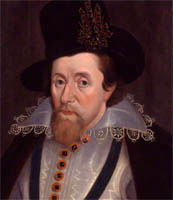 King James I (1567–1625). King from 1603 to 1625. |
A more diabolical duo could not be imagined than the Jezebel Mary Queen of Scots and Jesuit priest David Rizzio.
|
James was very unpopular in England, so to boost his popularity he staged a false-flag operation called the Gunpowder Plot. In 1618, he had Sir Walter Raleigh beheaded for "treason," and when the Pilgrim Fathers set sail for the New World in 1520, James bribed the captain of the Mayflower to drop them off hundreds of miles north of their intended destination. The king was "praying" that the world had seen the last of the Pilgrims.
James was the driving force behind the King James Bible. He wanted a new version of the Bible to replace the Geneva Version because he objected to the marginal notes that called the Pope, Antichrist.
The Stratford "Shakespeare" legend began with King James I
The Stratford male "Shakespeare" legend began during the reign of King James. With the publication of the First Folio in 1623, the myth continues right down to the present time.
|
This Stratford actor—nobody seems to know his real name yet—wrote no poetry during his lifetime . . . except for a brief inscription on his grave:
Good friend for Jesus sake forbear
To dig the dust enclosed here!
Blest be the man that spares these stones,
And curst be he that moves my bones.
Perhaps "Shakespeare" was worried that the fraud would be discovered and his body disinterred. He might have been thinking about the fate of the remains of Saint John Wycliffe–the Morning Star of the Reformation–whose bones were dug up; burned, and the ashes thrown into the Avon River. Up to the year 1902, pagan cremation was outlawed in Britain.
|
There is a funerary monument to "Shakespeare" in Holy Trinity Church, Stratford-on-Avon. Here is a quote about if from Wikipedia:
It is not known exactly when the monument was erected, but it must have been before 1623; in that year, the First Folio of Shakespeare's works was published, prefaced by a poem by Leonard Digges that mentions "thy Stratford moniment" [sic]. The monument was restored in 1748-9 and has been repainted several times. (Wikipedia article, Shakespeare's funerary monument).
The original funerary monument MUST NOT have been erected before 1623, because it bares no resemblance to the present monument. A book about "Shakespeare," written in 1709, has a completely different "Shakespeare." so the present monument must have been erected after 1709.
|
The original monument has Shakespeare resting his hands on a wool-sack or cushion. That must have been the origin "pulling the wool over your eyes."
Using a nom de plume or alias was quite common in England at that time. The most infamous example was pottymouth Sir Thomas More (patron saint of lawyers), who wrote a filthy Latin tome castigating Saint Martin Luther, entitled Responsio ad Lutherum. The language More used in condemning the blessed Reformation was so vile that he wrote under the pseudonym Guilielmus Rosseus (William Ross).Italian professor said that Shakespeare had profound knowledge of Italy!
A brilliant professor of Italian Language and Literature said that the Stratford Shakespeare had a remarkable familiarity with the Italian language, geography, and customs:
Shakespeare evinced a varied and profound knowledge of the country in general and of our cities in particular. His writings display the breath of his sympathy for Italy throughout the whole course of her glorious career. The loveliest lyrical passages in his plays are of the purest Italian inspiration. There is no poet, with the exception of Dante, who has loved our land more ardently than the great English dramatist. Innumerable are are the passages where he speaks of the special characteristics of our peninsula, of her history and of her customs. (Grillo, Shakespeare and Italy, p. 97).
Born in Italy, Grillo was Professor of English and German at the University of Urbino, 1903 to 1905, and Director of the Anglo-American Institute in Florence, 1905 to 1909. He succeeded Fernando Agnoletti as lecturer in Italian in the University in 1910 and he was Head of the Italian Department at the Athenaeum Commercial College in Glasgow, 1911 to 1940.
|
Unfortunately, professor Grillo–unlike Mark Twain–did not demolish the Stratford "Shakespeare" legend. The learned professor knew that the Stratford "Shakespeare" never visited Italy, so he surmised that "Shakespeare" gained his profound knowledge of Italy from books imported from that country:
Even the most casual readers of Shakespeare cannot fail to note the fact that the names of many of his characters are Italian, and that scenes in his dramas are often laid in one of the cities of Italy. Knowing little of the conditions prevailing in that period and nothing at all of Italian literature, they are astonished and seek an explanation. If, their curiosity being awakened, they carry their researches further, they will find that the chief dramatist of the English Renaissance, instead of inventing the stories which have entertained Europe for three centuries, was indebted not only for names, characters and scenes but also for entire plots and general inspiration to Italian books imported from Venice, Rome and Florence. Amazed at this discovery the student begins to waver in his opinion of Shakespeare, and wonders how much would remain if all extraneous borrowed elements were eliminated from the plays. (Grillo, Shakespeare and Italy, pp. 95-96). This autodidact Shakespeare is a myth because the Stratford Shakespeare did not leave a single book–Italian or English–in his last will and testament.
Professor Grillo should have brought his analysis of Shakespeare and Italy to its logical conclusion: the Stratford Shakespeare is a myth!!
Edward de Vere spent a year in Italy, from April 1575 to March 1576, and returned from that country with a male companion. Sir Francis Bacon also spent over a year on the Continent.
Vital links
"Anonymous" is a great movie that tries to prove that the male Edward de Vere was Shake-speare.
Burkert, Walter. Greek Religion: Archaic and Classical, Blackwell Publishing, Malden MA, 1985.
Castor, Helen. She-Wolves: The Women Who Ruled England Before Elizabeth. HarperCollins Publishers, New York, 2011.
Dawkins, Peter. The Shakespeare Enigma. Polair Publishing, London, 2004.
Durning-Lawrence, Sir Edwin. Bacon is Shake-speare. Greenwood Press Publishers, Westport, CT. (First published in 1910).
Gristwood, Sarah. Elizabeth & Leicester, Power, Passion, Politics. Viking Press, New York, 2007.
Grillo, Ernesto. Shakespeare and Italy. The University Press, Glasgow, Scotland, 1949.
Jones, Philippa. Elizabeth: Virgin Queen? Metro Books, New York, 2011.
Norton, Elizabeth. Bessie Blount: Mistress to Henry VIII. Amberley Publishing, Stround, Gloucestershire, UK, 2013.
Ogburn, Charlton. The Mysterious William Shakespeare, The Myth and the Reality. Dodd, Mead & Co., New York, 1984.
Streitz, Paul. Oxford: Son of Queen Elizabeth. Oxford Institute Press. Darien, CT. 2001.
Sobran, Joseph. Alias Shakespeare: Solving the Greatest Literary Mystery of All Time. The Free Press, New York, 1997.
Twain, Mark, Is Shakespeare Dead? Oxford University Press, New York, 1996. (Originally published in 1909).
Williams Neville, All the Queen's Men: Elizabeth and Her Courtiers. Weidenfeld & Nicolson, London, 1974.
Whitelock, Anna, The Queen's Bed: An Intimate History of Elizabeth's Court. Farrar, Straus & Giroux, New York, 2014.
Copyright © 2015 by Patrick Scrivener
